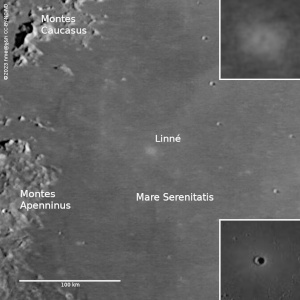
{
Practical astronomy
|
Astronomy
|
The Moon
|
The physical Moon
|
The Lunar 100
}
Lunar #82: Linné
The Montes Apenninus and Caucasus are separated by a passage leading from Mare Imbrium in the West to Mare Serenitatis in the East. About 100 km into Mare Serenitatis is the 3 km crater Linné within a slightly larger area of bright ejecta. This small crater caused controversy in the 19th century. The Atlas virtuel de la Lune (Chevalley and Legrand 2012a) includes this 1895 description by Elger:
A formation on the East side [in modern terminology the West side] of the Mare Serenitatis. described by Lohrmann and Mädler as a deep crater, but which in 1866 was found by Schmidt to have lost all the appearance of one. The announcement of this apparent change led to a critical examination of the object by most of the leading observers and to a controversy which, if it had no other result, tended to awaken an interest in selenography that has been maintained ever since. According to Mädler, the crater was more than 6 miles in diameter in his time and very conspicuous under a low sun, a description to which it certainly did not answer in 1867 or at any subsequent epoch. It is anything but an easy object to see well, as there is a want of definiteness about it under the best conditions. Though the minute crater, the low ridges, and the nebulous whiteness described by Schmidt and noted by Webb and others, are traceable at the proper phase. As in the case of Hyginus N, there are still many sceptics as regards actual change. despite the records of Lohrmann and Mädler, but the evidence in favour of it seems to preponderate.
Images:
- The area imaged on 2023-02-28, stacked from 600 video frames taken with a Schmidt-Cassegrain reflector of D = 200 mm and f = 3500 mm and Canon EOS 600Dα camera. The phase was +64%.
- Dto. with annotation and scale. The inserts are scaled up fourfold: Top right is from the same image with enhanced contrast, bottom right is from a screenshot from the Atlas virtuel de la Lune.


